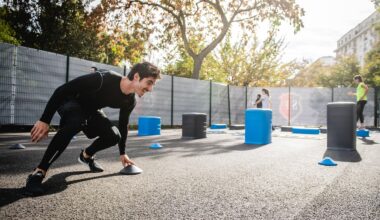Understanding the Mind-Body Connection
The mind-body connection is vital for anyone involved in fitness, especially when considering cognitive behavioral therapy (CBT) strategies. This area of focus brings awareness to how our thoughts influence physical performance. The interplay between mental states and physical conditions facilitates improved workouts and overall wellness. By acknowledging this connection, fitness enthusiasts can adopt strategies that integrate mental well-being with physical exercises. Many individuals find themselves in a cycle of negative thoughts that hinder their physical abilities. CBT helps identify these thoughts and promotes healthier cognitive patterns, allowing for improved emotional performance. Importantly, being educated about this relationship opens doors for greater success in fitness goals. Fitness professionals can benefit from being equipped with CBT techniques that elevate their training methods. Recognizing moments of mental resistance enables individuals to break barriers preventing optimal performance. Practicing mindfulness alongside relevant CBT strategies fosters a healthier perspective on fitness adaptations. Ultimately, the aim is not just to improve physical skills but also to cultivate a holistic approach where mind and body harmoniously work together for enhanced emotional performances. Understanding this connection allows for personal growth within the fitness realm, culminating in a more fulfilling experience.
To effectively utilize CBT strategies for emotional performance, identifying negative thought patterns is crucial. Negative self-talk can undermine motivation and hinder progress, making it essential to address these issues head-on. Techniques such as cognitive restructuring can assist in reframing negative thoughts into positive affirmations. For instance, individuals often think, “I can never complete this workout.” Instead, replacing it with, “I am capable, and I will improve with each session” encourages a more productive mindset. Journaling can also complement these strategies by serving as an outlet for emotions and a tool to track progress. This awareness can lead to the discovery of patterns that warrant change. Additionally, developing a strong support system will provide encouragement during challenging times. Friends, family, or personal trainers can reinforce positive narratives that benefit emotional health. Another key aspect of these strategies includes visualization techniques. Athletes and fitness lovers can visualize successful outcomes, creating a mental image of achieving personal bests. This technique not only boosts confidence but also enhances motivation levels. The amalgamation of these strategies reveals a powerful pathway toward conquering mental barriers that could impede physical performance in fitness.
Mindfulness Practices in Fitness
Mindfulness practices combine seamlessly with CBT approaches to elevate emotional performance in fitness. Mindfulness cultivates an awareness of the present moment, allowing individuals to engage wholly in their physical activities. For example, during a workout, one may notice fluctuating thoughts and feelings that typically arise. Instead of suppressing them, mindfulness encourages acknowledgment and acceptance, which can reduce anxiety about performance. Simple mindfulness techniques such as deep breathing can ground individuals, transforming their approach to various physical challenges. With the inclusion of mindfulness, fitness practitioners become more adept at managing stressors that arise during workouts. Additionally, incorporating a body scan meditation enhances body awareness, enabling individuals to connect with different muscle groups effectively. As individuals embrace their thoughts without judgment, they cultivate a more supportive internal dialogue. This aspect significantly influences emotional outcomes related to fitness goals. Moreover, integrating gratitude practices can amplify the sense of accomplishment after each workout session. Individuals who recognize their efforts, regardless of the intensity or quality of the session, cultivate a mindset geared toward improvement. Overall, mindfulness enhances both mental and physical aspects of fitness, creating a symbiotic relationship that supports emotional performance.
Acknowledging emotional obstacles is essential for maximizing fitness potential. Implementing CBT strategies hinges on recognizing these barriers, which could manifest as fear of failure or self-doubt. An essential step in this process involves setting realistic, achievable goals, ensuring that they remain tangible throughout the journey. Breaking down larger goals into smaller milestones can foster a sense of accomplishment while diminishing anxiety about lofty expectations. Additionally, individuals can employ the SMART criteria—Specific, Measurable, Achievable, Relevant, and Time-bound—when developing these fitness goals. This structured approach assists in clarifying objectives, making it easier to chart progress along the way. Furthermore, keeping a fitness log can reinforce commitment while highlighting emotional fluctuations during workouts. The insight gleaned from these logs enables individuals to adapt their strategies, responding to emotional challenges more effectively. Alongside goal-setting, creating a positive environment contributes significantly to emotional performance. Surrounding oneself with uplifting, encouraging influences can bolster motivation levels while minimizing self-sabotaging thoughts. Ultimately, prioritizing emotional intelligence and understanding the nuances of one’s feelings can lead to sustained engagement in fitness activities, promoting a healthier mind-body integration.
Building Resilience Through Exercise
Exercise acts as a natural antidote for managing stress and building resilience. Regular physical activity releases endorphins, which are natural mood lifters that bolster mental well-being. Engaging in fitness as a way of coping with stress empowers individuals to tackle challenges head-on, fostering emotional strength. Moreover, through structured CBT techniques, individuals can link their experiences in fitness to personal resilience. For instance, learning to navigate the discomfort of challenging workouts can translate to better handling of stressors outside the gym. Reflection upon these experiences aids in developing strategies that reinforce resilience across different life aspects. Emphasizing the importance of diverse workout adaptations can also prevent mental fatigue, enhancing overall engagement. Participating in various activities keeps the mind stimulated and reduces monotony, allowing for a broader emotional experience. Additionally, exploring new fitness modalities can spark joy and excitement, encouraging a sustained commitment to physical well-being. Building relationships within fitness communities can further strengthen resilience, creating a supportive network. These interactions can serve as an affirmation of shared goals, further boosting emotional performance. The cumulative effect of resilience found in consistent exercise can enhance confidence and deepen the mind-body connection.
Incorporating positive reinforcement techniques can boost motivation and emotional performance outcomes. Celebrating small victories creates a sense of accomplishment, reminding individuals of their hard work and progress. Implementing reward systems for reaching specific benchmarks can offer additional encouragement. Whether treating oneself to a healthy snack or taking a moment of relaxation, these rewards create compelling incentives. Positive affirmations also play a crucial role in fostering a constructive mindset. Using phrases like, “I exercise because I love my body” shifts the focus from perceived obligations to motivation grounded in self-love. Consistently integrating these affirmations supports a positive self-image, enhancing overall emotional resilience in fitness pursuits. Moreover, refining one’s environment to reflect positivity can help reinforce this mindset. Surrounding oneself with inspiring images or motivational quotes can significantly influence emotional performance. As commitment grows, individuals should reflect on their journey frequently, celebrating achievements and acknowledging emotional growth amidst workouts. This comprehensive analysis of experiences enriches self-awareness, creating a greater understanding of personal milestones in fitness. Ultimately, the fusion of positive reinforcement, mindfulness techniques, and emotional acknowledgment crafts a well-rounded approach to enhancing performance in physical activities.
Conclusion: Commitment to Emotional Health in Fitness
In conclusion, the journey toward improved emotional performance in fitness begins with understanding and leveraging the mind-body connection. Engaging with CBT strategies, including reframing negative thoughts, integrating mindfulness practices, and building resilience, lays a strong foundation for success. Each of these techniques plays a pivotal role in helping fitness enthusiasts navigate the emotional landscape that accompanies their physical journeys. As individuals commit to enhancing emotional health, they will experience an overflow of benefits both inside and outside the gym. By nurturing the relationship between mind and body, participants unlock the potential for holistic well-being. Remaining adaptable and open to change encourages progress while deepening the experience of fitness. Therefore, prioritizing emotional aspects may well lead to lasting transformations for practitioners, cultivating a sense of fulfillment. Attaining emotional goals harmoniously balances physical accomplishments, allowing individuals to thrive in their fitness endeavors. With the tools and strategies introduced in CBT, anyone can cultivate a healthier mindset, ultimately bridging the gap between mental and physical achievement. The pursuit of emotional performance through fitness remains a profoundly rewarding experience, cementing personal growth along the way.
This article explores the CBT strategies that optimize emotional performance in fitness activities. Each section delves into the multifaceted relationship between cognitive approaches and physical activity.


